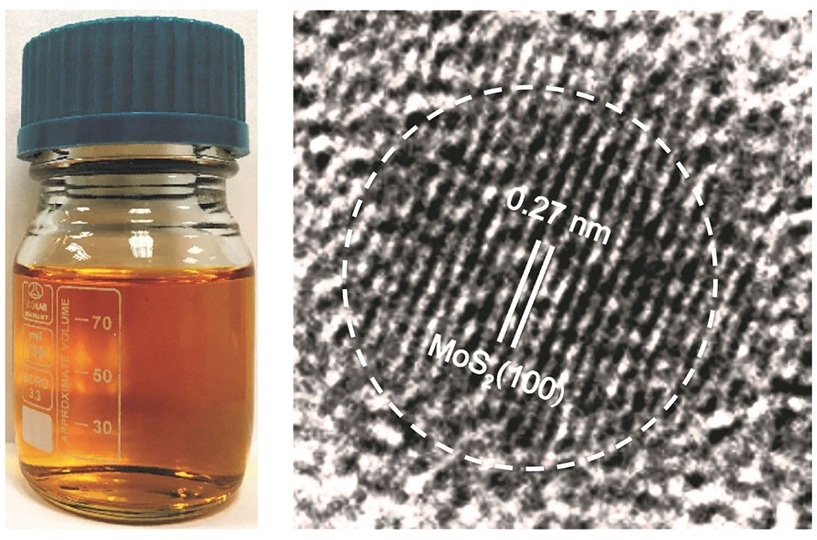Jan 28 2019
Two-dimensional (2D) transition metal dichalcogenides (TMDs) nanomaterials like molybdenite (MoS2), with a structure similar to graphene, have been accepted as futuristic materials for their broad array of potential applications in sensors, biomedicine, photodetectors, catalysts, and energy storage devices.
 MoS2 quantum dots in aqueous solution (left) and an ultrahigh magnification of a MoS2 quantum dot (right). MoS2 quantum dots synthesized with the new approach developed by NUS researchers can potentially generate cancer-killing properties. (Image credit: National University of Singapore)
MoS2 quantum dots in aqueous solution (left) and an ultrahigh magnification of a MoS2 quantum dot (right). MoS2 quantum dots synthesized with the new approach developed by NUS researchers can potentially generate cancer-killing properties. (Image credit: National University of Singapore)
TMD quantum dots (QDs), which are the smaller counterparts of 2D TMDs, further intensify the electronic and optical properties of TMDs and can be exploited well for biomedical and catalytic applications. However, TMD QDs are not used much in applications as it is still very difficult to synthesize them.
Currently, engineers at the National University of Singapore (NUS) have devised a scalable and cost-effective approach to produce TMD QDs. The new approach also enables the characteristics of TMD QDs to be engineered in particular for various applications, thus taking a stride forward in helping to achieve the potential of TMD QDs.
Bottom-Up Strategy to Synthesize TMD QDs
The existing methods for producing TMD nanomaterials are dependent on a top-down approach which involves collecting TMD mineral ores and breaking them down from millimeter to nanometer scale through chemical or physical processes. Although this approach is effective in producing TMD nanomaterials with precision, its scalability is low and is costly since the separation of the nanomaterials fragments by size mandates the application of multiple purification processes. The use of the same technique to synthesize TMD QDs of consistent size is also highly challenging owing to their very small size.
In order to solve this problem, a group of engineers from the Department of Chemical and Biomolecular Engineering at NUS Faculty of Engineering devised an innovative bottom-up synthesis approach that can be used to consistently build TMD QDs of a particular size, a more scalable and less-costly method compared to the traditional top-down strategy. The TMD QDs are produced by making transition metal oxides or chlorides to react with chalogen precursors under room temperature and mild aqueous conditions. The researchers were able to use the bottom-up strategy to successfully produce a small collection of seven TMD QDs and could to modify their optical and electronic properties accordingly.
Associate Professor David Leong from the Department of Chemical and Biomolecular Engineering at NUS Faculty of Engineering headed the development of this innovative synthesis technique.
Using the bottom-up approach to synthesise TMD QDs is like constructing a building from scratch using concrete, steel and glass component; it gives us full control over the design and features of the building. Similarly, this bottom-up approach allows us to vary the ratio of transition metal ions and chalcogen ions in the reaction to synthesise the TMD QDs with the properties we desire. In addition, through our bottom-up approach, we are able to synthesise new TMD QDs that are not found naturally. They may have new properties that can lead to newer applications.
David Leong, Associate Professor, Department of Chemical and Biomolecular Engineering, NUS Faculty of Engineering
Applying TMD QDs in Cancer Therapy and Beyond
Then, the group of NUS engineers produced MoS2 QDs for the purpose of demonstrating proof-of-concept biomedical applications. Using their experiments, the researchers demonstrated that it is possible to engineer the defect properties of MoS2 QDs with precision by employing the bottom-up strategy to produce differing levels of oxidative stress, and hence, it can be used for photodynamic therapy, an emerging cancer therapy.
Photodynamic therapy currently utilises photosensitive organic compounds that produce oxidative stress to kill cancer cells. These organic compounds can remain in the body for a few days and patients receiving this kind of photodynamic therapy are advised against unnecessary exposure to bright light. TMD QDs such as MoS2 QDs may offer a safer alternative to these organic compounds as some transition metals like Mo are themselves essential minerals and can be quickly metabolised after the photodynamic treatment. We will conduct further tests to verify this.
David Leong, Associate Professor, Department of Chemical and Biomolecular Engineering, NUS Faculty of Engineering
However, the potential of TMD QDs is far more than just for biomedical applications. As a step forward, the researchers are striving to expand their collection of TMD QDs with the help of the bottom-up approach as well as to optimize them for other applications, for example, advanced electronic components, next-generation electronic device and TV screens, and even solar cells.
The outcomes of the study were reported in Nature Communications, a prestigious scientific journal, on January 3rd, 2019.